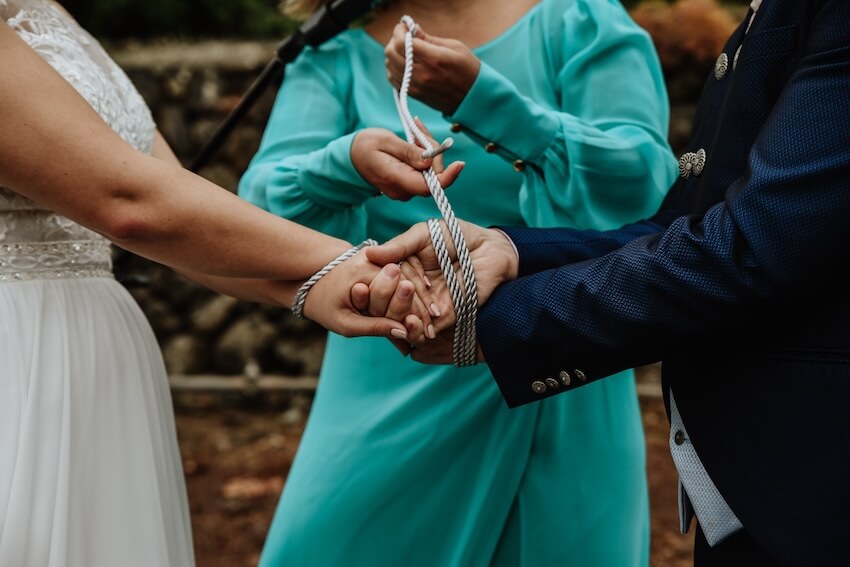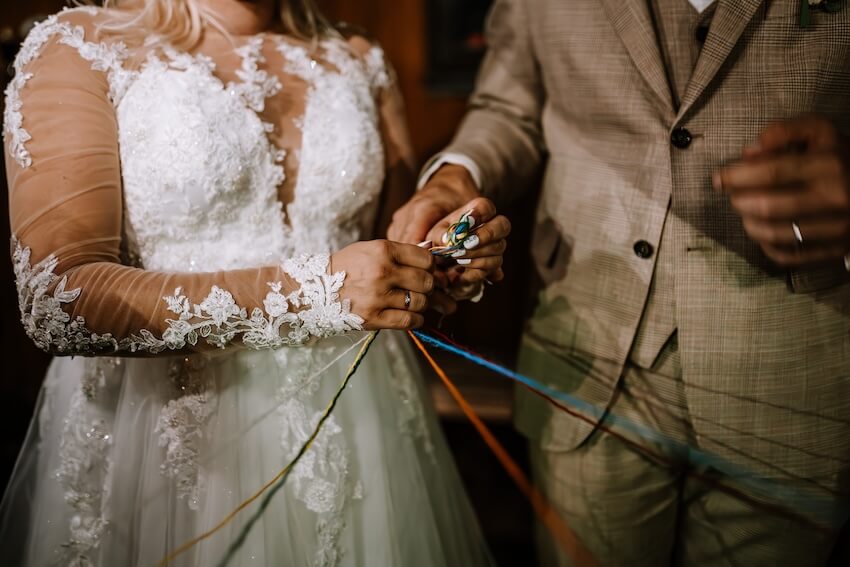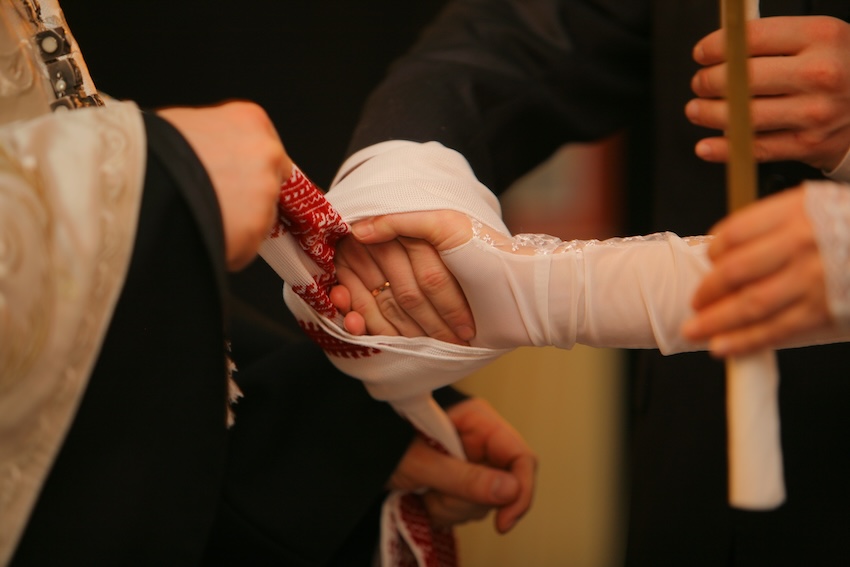Your Handfasting Ceremony Guide: How to Make It Happen

Saying “I do” is a magical moment and many couples look for ways to make the occasion more meaningful and symbolic. One option is a handfasting ceremony, an ancient tradition that uses a ribbon to tie the couple’s hands together in a symbol of unity.
In this article, you’ll learn more about the history and significance of handfasting ceremonies. We’ll also show you how to plan one with an easy step-by-step guide. Plus, you’ll find suggestions for incorporating personal touches and making the ceremony memorable.
What Is a Handfasting Ceremony?
A handfasting ceremony is a ritual where the couple’s hands are tied together using a ribbon or cord. The exact origins of handfasting traditions are murky since this practice is seen in various cultures, including Chinese and Celtic communities. It was traditionally used in Wiccan and Pagan wedding ceremonies but has become trendier in recent years.Â
Today, you’ll see this unity ritual as part of secular and religious weddings across the globe. From British, Irish, and American couples to communities in Asia and Latin America, handfasting lets celebrants symbolize their love in a special ceremony.Â
Significance and History of Handfasting Ceremonies

Handfasting ceremonies play an important role in many communities. In China, the Red Thread of Fate is a legend where the god of marriage tied an invisible red string between the ankles of couples who were destined to get married. In ceremonies, couples tie a red thread around their hands and fingers in honor of this legend.
In Scotland and Ireland, the ancient Celtic tradition of handfasting dates back thousands of years. A couple went before a priest, who tied a braided red cord around their arms. This Celtic handfasting showed others that they were betrothed. Over the years, the Celts incorporated this tradition into the actual wedding ceremony. The cord was used to tie the couple’s hands together as a symbol of unity.Â
The phrase “tying the knot” comes specifically from this practice of tying hands together in a symbolic ceremony. The Scottish used the Old Norse word for the ceremony, “hand-festa,” which translates to “to strike a bargain by joining hands.”Â
The clear symbolism of this ceremony is the joining of two souls in one union. The handfasting cord is often saved as a keepsake after the wedding to symbolize a continued union.
Step-By-Step Guide to a Handfasting Ceremony

Ready to start planning your very own handfasting ceremony? Follow this step-by-step guide to easily incorporate this special tradition into your wedding day.
1. Choose When to Have the Handfasting
While handfasting ceremonies are common in the marriage ceremony on the actual wedding day, you can also plan one for your engagement party or when you move in together instead. Sit down together and decide when you want to plan the symbolic act.Â
2. Find an Officiant
An officiant oversees the handfasting ceremony. In ancient times, this was typically a priest. Today, you can have your wedding officiant perform the handfasting ritual, ask a loved one or family member to do the honors, or hire a professional who does these events regularly.
3. Gather Supplies
You’ll need a few items before the big day. Couples should first decide what type of cord or ribbon they want to use for the wedding ritual. There are many different options, from silk string to nautical rope, to reflect the personality and interests of the couple. Some people use an article of clothing, like a silk scarf from a grandmother, that has meaning.
You can also choose a ribbon or cord that matches your wedding theme. For a rustic wedding, burlap string or natural vines are a great option. For a winter wedding, a silver ribbon decorated with crystal charms is the perfect addition.
In ancient times, the cords were braided, so most couples today choose to use three handfasting ribbons that can be braided over their hands. But it’s your big day, so if you want something more elaborate or simple`, go with that!Â
Aim to get cords or ribbons that are about 3 feet long so they can be wrapped around your hands a few times. You’ll want added length if you plan on doing elaborate knots like an infinity knot or Celtic knot.
4. Write a Ceremony Script
Write a brief script for your unity ceremony to explain the tradition and guide everyone through the process. It doesn’t need to be very long or detailed. Instead, think of it as a quick guide to what you’re doing and what it means.
5. Decide if You Want Additional Rituals
Some couples choose to incorporate other rituals as part of the handfasting ceremony. These may include keeping your hands tied while doing the ring exchange or reading your wedding vows.
6. Practice Before the Big Day
While this traditional wedding ritual is fairly simple, it’s helpful to practice beforehand. That way, you know exactly how you’ll tie the knot on the big day.Â
Tips for a Memorable Handfasting Ceremony

Handfasting ceremonies themselves are memorable since they give guests a visual depiction of you tying the knot. You can make them extra special by adding personal touches that are significant to you as a couple.
Pick a Unique Material
One idea is to put time and thought into choosing the cords.Â
For example, if you love sailing, you can use nautical rope to tie your hands together — and make it extra special by using sailing knots.Â
Be creative with the color and pick cords that represent your home countries, birthstones, or wedding colors.
Or, use an item of clothing that has meaning. A ribbon that your mother used to tie up her hair or a strip of linen from the first place you lived together is the perfect sentimental pick.
Add Personal Touches to the Cord
Once you have a cord that fits you as a couple, you can further personalize it. There are no rules! Charms that represent your personality, seashells from your favorite beach, or flowers from your garden can make it more personal.Â
You could also write a copy of your vows directly on a piece of ribbon.
Pick a Style of Tying That Reflects You
Consider how you want to tie your hands together. Many couples choose to cross their hands and tie them together that way. Others choose to tie their hands individually using a single ribbon each and then use a third ribbon to tie them together, symbolizing individuality and the resulting union.
Add Loved Ones to the Handfasting
Make the moment unique by getting family members in on the fun. Add extra cords so family members like your parents or siblings can participate and tie your hands together. For something more involved, consider giving each person in your wedding party a ribbon to tie your hands with.
Join Together in a Symbolic Union

With a handfasting ceremony, you can symbolize your love and the act of joining together as one. Use these tips to make the ceremony more personal and reference our step-by-step guide to plan the ritual.
When you’re ready, ask guests to join you on your special day using online wedding invitations. You can reference the handfasting ceremony so guests know what to expect or just surprise them with the ritual on the big day. Best of all, each invite is easy to customize so you can match themes, including color palettes, to your handfasting ceremony.
For more wedding planning ideas, continue browsing our Stationers blog. You’ll find plenty of inspiration from wedding decor ideas to tips for etiquette and planning the big day. Plus, it’s packed with ideas to make your special moment more memorable and unique to your love story.Â


